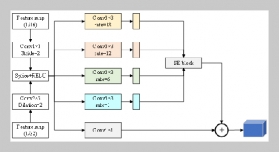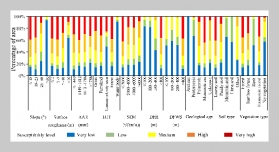- [1] E. Hassankhani and M. Esmaeili-Falak, (2024) “Soil–Structure Interaction for Buried Conduits Influenced by the Coupled Effect of the Protective Layer and Trench Installation" Journal of Pipeline Systems Engineer�ing and Practice 15: 04024012. DOI: https://doi.org/10.1061/JPSEA2.PSENG-1547.
- [2] R. S. Benemaran, (2017) “Experimental and analytical study of pile-stabilized layered slopes" Civil engineer�ing, Tabriz university, Tabriz, Thesis:
- [3] M. J. Mosquera, T. Rivas, B. Prieto, and B. Silva, (2000) “Capillary rise in granitic rocks: interpretation of kinetics on the basis of pore structure" Journal of Colloid and Interface Science 222: 41–45. DOI: https://doi.org/10.1006/jcis.1999.6612.
- [4] M. Esmaeili-Falak, H. Katebi, and A. Javadi, (2018) “Experimental study of the mechanical behavior of frozen soils-A case study of tabriz subway" Periodica Poly�technica Civil Engineering 62: 117–125. DOI: https://doi.org/10.3311/PPci.10960.
- [5] R. S. Benemaran, M. Esmaeili-Falak, and M. S. Kord�lar, (2024) “Improvement of recycled aggregate concrete using glass fiber and silica fume" Multiscale and Mul�tidisciplinary Modeling, Experiments and Design 7: 1895–1914. DOI: https://doi.org/10.1007/s41939-023-00313-2.
- [6] M. Karoglou, A. Moropoulou, A. Giakoumaki, and M. K. Krokida, (2005) “Capillary rise kinetics of some building materials" Journal of colloid and interface science 284: 260–264. DOI: https://doi.org/10.1016/j.jcis.2004.09.065.
- [7] A. Bozda˘g, ˙I. ˙Ince, A. Bozda˘g, M. E. Hatır, M. B. To�sunlar, and M. Korkanç, (2020) “An assessment of dete�rioration in cultural heritage: The unique case of Eflatunpı�nar Hittite Water Monument in Konya, Turkey" Bulletin of Engineering Geology and the Environment 79: 1185–1197. DOI: https://doi.org/10.1007/s10064-019-01617-9.
- [8] S. J. I’anson and W. D. Hoff, (1986) “Water movement in porous building materials—VIII. Effects of evaporative drying on height of capillary rise equilibrium in walls" Building and Environment 21: 195–200. DOI: https://doi.org/10.1016/0360-1323(86)90030-2.
- [9] N. Cueto, D. Benavente, J. Martínez-Martínez, and M. A. García-del-Cura, (2009) “Rock fabric, pore geom�etry and mineralogy effects on water transport in frac�tured dolostones" Engineering geology 107: 1–15. DOI: https://doi.org/10.1016/j.enggeo.2009.03.009.
- [10] I. Tomaši´c, D. Luki´c, N. Peˇcek, and A. Kršini´c, (2011) “Dynamics of capillary water absorption in natural stone" Bulletin of Engineering Geology and the Environ�ment 70: 673–680. DOI: https://doi.org/10.1007/s10064-011-0355-x.
- [11] ˙I. Dinçer and M. Bostancı, (2019) “Capillary water ab�sorption characteristics of some Cappadocian ignimbrites and the role of capillarity on their deterioration" Envi�ronmental earth sciences 78: 1–18. DOI: https://doi.org/10.1007/s12665-018-7993-2.
- [12] D. Benavente, C. Pla, N. Cueto, S. Galvañ, J. Martínez�Martínez, M. A. García-del-Cura, and S. Ordóñez, (2015) “Predicting water permeability in sedimentary rocks from capillary imbibition and pore structure" Engi�neering Geology 195: 301–311.
- [13] N. Sengun, S. Demirdag, D. Akbay, I. Ugur, R. Al�tindag, and A. Akbulut. “Investigation of the relation�ships between capillary water absorption coefficients and other rock properties of some natural stones, V”. In: Global stone congress. 2014, 22–25.
- [14] H. Stück, S. Siegesmund, and J. Rüdrich, (2011) “Weathering behaviour and construction suitability of di�mension stones from the Drei Gleichen area (Thuringia, Germany)" Environmental Earth Sciences 63: 1763–1786. DOI: 10.1007/s12665-011-1043-7.
- [15] ˙I. ˙Ince, (2021) “Relationship between capillary water ab�sorption value, capillary water absorption speed, and cap�illary rise height in pyroclastic rocks" Mining, Metal�lurgy & Exploration 38(2): 841–853. DOI: 10.1007/s42461-020-00354-y.
- [16] M. Esmaeili-Falak and R. S. Benemaran, (2023) “En�semble deep learning-based models to predict the resilient modulus of modified base materials subjected to wet-dry cycles" Geomechanics and Engineering 32(6): 583– 600. DOI: 10.12989/gae.2023.32.6.583.
- [17] M. Esmaeili-Falak and R. Sarkhani Benemaran, (2024) “Application of optimization-based regression analysis for evaluation of frost durability of recycled aggregate con�crete" Structural Concrete 25(1): 716–737. DOI: 10. 1002/suco.202300566.
- [18] Y. Dawei, Z. Bing, G. Bingbing, G. Xibo, and B. Razza�ghzadeh, (2023) “Predicting the CPT-based pile set-up parameters using HHO-RF and PSO-RF hybrid mod�els" Structural Engineering and Mechanics, An Int’l Journal 86(5): 673–686.
- [19] M. Esmaeili-Falak and R. S. Benemaran, (2024) “En�semble extreme gradient boosting based models to predict the bearing capacity of micropile group" Applied Ocean Research 151: 104149. DOI: 10.1016/j.apor.2024.104149.
- [20] ˙I. Dinçer, A. Özvan, M. Akın, M. Tapan, and V. Oyan, (2012) “˙Ignimbiritlerin kapiler su emme potansiyellerinin de˘gerlendirilmesi: Ahlat Ta¸sı örne˘gi" Yüzüncü Yıl Üniversitesi Fen Bilimleri Enstitüsü Dergisi 17(2): 64–71.
- [21] P. Vázquez, F. Alonso, R. Esbert, and J. Ordaz, (2010) “Ornamental granites: Relationships between p-waves ve�locity, water capillary absorption and the crack network" Construction and Building Materials 24(12): 2536– 2541. DOI: 10.1016/j.conbuildmat.2010.06.002.
- [22] ˙I. Çobano˘glu, (2015) “Prediction and identification of capillary water absorption capacity of travertine dimen�sion stone" Arabian Journal of Geosciences 8: 10135– 10149. DOI: 10.1007/s12517-015-1902-8.
- [23] ˙I. ˙Ince, A. Bozda˘g, M. Barstu˘gan, and M. Fener, (2021) “Evaluation of the relationship between the physical prop�erties and capillary water absorption values of building stones by regression analysis and artificial neural net�works" Journal of Building Engineering 42: 103055. DOI: 10.1016/j.jobe.2021.103055.
- [24] M. Esmaeili-Falak, H. Katebi, M. Vadiati, and J. Adamowski, (2019) “Predicting triaxial compressive strength and Young’s modulus of frozen sand using arti�ficial intelligence methods" Journal of Cold Regions Engineering 33(3): 04019007. DOI: 10.1061/(ASCE) CR.1943-5495.0000188.
- [25] K. Zhang, Y. Zhang, and B. Razzaghzadeh, (2024) “Application of the optimal fuzzy-based system on bearing capacity of concrete pile" Steel and Composite Struc�tures 51(1): 25. DOI: 10.12989/scs.2024.51.1.025.
- [26] M. G. Culshaw, (2015) “Ulusay, R (ed.), 2015. The ISRM suggested methods for rock characterization, test�ing and monitoring: 2007–2014: Cham, Switzerland: Springer." Bulletin of Engineering Geology and the Environment 74: 1499–1500. DOI: DOI10.1007/978-3-319-007713-0.
- [27] T. En et al., (2000) “Natural stone test methods�Determination of water absorption coefficient by capil�larity" CNR-ICR, Rome:
- [28] R. S. Benemaran and M. Esmaeili-Falak, (2023) “Pre�dicting the Young’s modulus of frozen sand using ma�chine learning approaches: State-of-the-art review" Ge�omechanics and Engineering 34(5): 507–527. DOI: 10.12989/gae.2023.34.5.507.
- [29] E. Atashpaz-Gargari and C. Lucas. “Imperialist com�petitive algorithm: an algorithm for optimization in�spired by imperialistic competition”. In: 2007 IEEE congress on evolutionary computation. Ieee. 2007, 4661– 4667. DOI: 10.1109/CEC.2007.4425083.
- [30] A. Zadeh Shirazi and Z. Mohammadi, (2017) “A hy�brid intelligent model combining ANN and imperialist competitive algorithm for prediction of corrosion rate in 3C steel under seawater environment" Neural Computing and Applications 28(11): 3455–3464. DOI: 10.1007/s00521-016-2251-6.
- [31] M. Elsisi, (2019) “Design of neural network predictive controller based on imperialist competitive algorithm for automatic voltage regulator" Neural Computing and Applications 31(9): 5017–5027. DOI: 10.1007/s00521-018-03995-9.
- [32] S. Hosseini and A. Al Khaled, (2014) “A survey on the imperialist competitive algorithm metaheuristic: im�plementation in engineering domain and directions for future research" Applied Soft Computing 24: 1078–1094. DOI: 10.1016/j.asoc.2014.08.024.
- [33] L. T. Le, H. Nguyen, J. Dou, and J. Zhou, (2019) “A comparative study of PSO-ANN, GA-ANN, ICA-ANN, and ABC-ANN in estimating the heating load of build�ings’ energy efficiency for smart city planning" Applied Sciences 9(13): 2630. DOI: 10.3390/app9132630.
- [34] C. Cortes and V. Vapnik, (1995) “Support-vector net�works" Machine learning 20: 273–297. DOI: 10.1007/BF00994018.
- [35] H. Nguyen, (2019) “Support vector regression approach with different kernel functions for predicting blast-induced ground vibration: a case study in an open-pit coal mine of Vietnam" SN Applied Sciences 1(4): 283. DOI: 10.1007/s42452-019-0295-9.
- [36] X.-N. Bui, H. Nguyen, H.-A. Le, H.-B. Bui, and N.-H. Do, (2020) “Prediction of blast-induced air over-pressure in open-pit mine: assessment of different artificial intelli�gence techniques" Natural Resources Research 29(2): 571–591. DOI: 10.1007/s11053-019-09461-0.
- [37] J.-S. Jang, (1993) “ANFIS: adaptive-network-based fuzzy inference system" IEEE transactions on systems, man, and cybernetics 23(3): 665–685. DOI: 10.1109/21.256541.
- [38] B. Sethy, C. Patra, N. Sivakugan, and B. Das, (2017) “Application of ANN and ANFIS for predicting the ulti�mate bearing capacity of eccentrically loaded rectangular foundations" International Journal of Geosynthet�ics and Ground Engineering 3: 1–14. DOI: 10.1007/s40891-017-0112-8.
- [39] R. Sahu, C. Patra, N. Sivakugan, and B. Das, (2017) “Use of ANN and neuro fuzzy model to predict bearing capacity factor of strip footing resting on reinforced sand and subjected to inclined loading" International Journal of Geosynthetics and Ground Engineering 3: 1–15. DOI: 10.1007/s40891-017-0102-x.
















